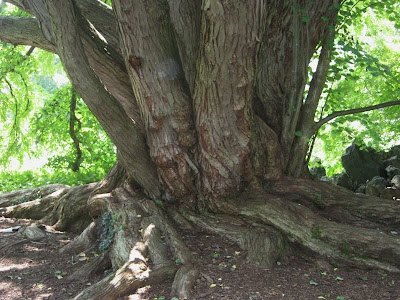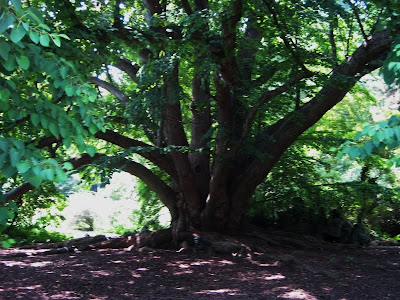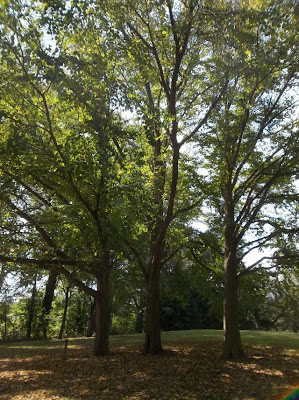Friday, March 7, 2014
Katsura Tree
The first time I ever seen a Katsura I remember was back while in high school and I was visiting in Niagara Falls, Ontario and seen 3 large shade trees on a front lawn that were not only perfect in shape but also had very beautiful foliage and intresting bark. They appeared somewhat similar in foliage to the Redbud but I knew it wasnt. Was intreagued to come across a tree that I had not previously known. While not a common tree; the Katsure Tree is very much at home and grows very vigorously in southern Ontario, Canada and the New England region of the U.S. though it also grows well much further south into North Carolina if not exposed to excessive reflective heat ( thus not meant for the local Walmart parking lot ).
This Oriental ( Japan through Himalayas ) native, eventually forms a large tree yet retaining its elegant horizontal branching habit. Broadly pyramidal when young; the Katsura tree eventually forms a massive domed crown resembling an open grown Oak. A very long lived tree; its mature size in the U.S. is still unknown but possibly over 100 feet. Indeed some have alreadt reached 82 feet or slightly more in both Philadelphia and Fort Wayne, Indiana. The U.S.A. champion grows at Phillys Morris Arboretum ( approx 72 x 100 feet x 7.5 feet diam. ). Another large tree ( 101 x 72 x 4.5 feet grows in Hartford, CT ).
In its native habitat; the Katsura rivals the Ginkgo and the Tulip Tree as among the worlds largest temperate hardwoods. Some records include: first year from seed - 5 feet; fastest growth rate - 6 feet; 5 years - 25 feet; 20 years - 45 feet; 30 years - 60 x 30 feet;
52 years - 78 x 50 feet with a trunk diameter of 3.1 feet; 370 years - 150 feet with a trunk diameter of 10 feet; largest ever recorded - 180 x 82 feet with a trunk diameter of 22 feet!
One of the worlds longest living hardwoods; the Katsura tree can last up to 2000 years in age and is rarely bothered by either insect pests or disease.
It makes an attractive street tree in the cooler parts of its range where reflected heat and drought wont scorch its leaves or stunt its growth.
The foliage resembles that of the unrelated Cercis - Redbud. It is reddish when unfolding turning to blue-green and is up to 4 x 4 inches or less often 6 x 6 inches on very vigorous shoots. The autumn color on the Katsura is exceptional!!! In full sun the colors can be intense and often multiple colors ( red, pinks and yellows ) occur on the same tree. In autumn the foliage is also cotton candy smelling aromatic.
The tiny early spring flowers borne from the leaf axils are not an ornamental feature simply because they are so small. They are followed by a curved, small, green pod.
The brown shaggy bark is very attractive in all seasons.
Hardy zones 4 to 8 ( possibly zones 2 and 3 however this is an estimation based on using seed source from the far northern part of the trees natural range planted into sheltered locations only ). It has been reported to grow in Winnipeg and in fact generally do like climates with hot summers and cold winters.
. Though very different in appearance; the Katsura is related to the Magnolias and enjoys similar growing conditions.
The Katsura does not like root compaction and grows best on deep, moist, fertile acidic, well drained soil though it more tolerant ( in fact it grew very well on almost pure sand in Leamington, ON with extra fertilizer and absence of turf competition ). The Katsura is also clay tolerant. This tree can be grown in sun or shade, though forest grown trees tend to be tall and thin. Young trees should be pruned to a single leader and feathered with lower branches eventually limbed up to form a tree that can be walked under. The best time to prune is in March. This tree does not like to be transplanted at large sizes however small trees can establish rapidly when planted while dormant. Easy to grow and deer resistant; they are virtually immune to insect pests or disease. Katsuras leaf out early and is thus not recommended in mountain valleys or other areas prone to late freezes. It also prefers to be somewhat sheltered and is more at home on a wooded lot than on the side of a freeway or farmers field.
Propagation from seed is easy however the seed needs to go through a "chilling" period before they germinate. As for the cultivars; they are readily reproduced from cuttings taken in late spring or summer and root easily as long as kept cool and moist.
TURF GRASS COMPETITION STUNTS GROWTH OF KATSURA ( in many cases to half or less than figures quoted above )
* photos taken on April 28 2010 in Clarksville, MD


* photo taken on May 16 2010 @ Cylburn Arboretum, Baltimore, MD


* photos taken on 4th of July 2010 in Washington, D.C.


* photos taken on July 17 2010 @ Morris Arboretum, Philly, PA




















* photos taken on August 3 2010 @ University of Guelph Arboretum, Ontario



* photo taken on August 4 2010 @ Stratford, Ontario

* photos taken on Sep 16 2013 in Columbia, MD



Amazing Grace
Forms a massive mound of cascading branches. It can eventually reach 25 x 30 feet though only about 12 x 12 feet in 10 years. Foliage turns attractive yellow-orange in autumn. Not as hardy as the coldest region seed source of regular Katsura but can still survive north into zone 4
* photo taken on May 21 2011 @ Brookside Gardens "Party with the Peonies" tour in Fulton, MD


Heronswood Globe
A dwarf form, forming a bushy, dense, rounded, small tree, reaching a maximum size of 20 x 20 feet. Some records include: 10 years - 8 x 6.5 feet.
Vigorous when young, unlike the parent trees which grows huge, this cultivar slows down considerably as it matures.
Purpurea
a rare cultivar with deep purple spring foliage that turns to dark purple green in summer. It also forms a large tree.
Raspberry
Reaches up to 60 x 4o feet with foliage that is reddish in spring, green in summer then red in autumn.
Sinensis
No major differance except possibly even faster growing ( record growth rate - 8 feet ). The foliage is somewhat downy beneath.
Strawberry
Foliage turns to scarlet in fall rather than the typical mix of colors.
Cercidiphyllum magniphyllum
Similar to Cercidiphyllum japonicum but with larger leaves to around 5 inches
Cercidiphyllum magniphyllum Pendulum ( Weeping Katsura )
The Weeping Katsura tree grows in the same shape of the Weeping Willow but is much more low maintenance. It matures into a very beautiful weeping tree and is infact among my favorites of all weeping specimum trees. It is very fast growing and some records include: fastest growth rate - 7 feet; 6 year size - 25 feet ) but soon slows down to a mature size around 35 x 30 feet, though after 100 years may become much larger. One in Japan is 75 feet in height with a trunk diameter of 4.7 feet at an age of 170 years.
Its leaves are cordate to rounded, are up to 6 x 6 inches and are blue-green in color. They turn yellows, oranges and red in the fall and often with all colors on the same tree.
* photo taken @ U.S. National Arboretum, D.C. on Feb 2009

* photo taken @ U.S. National Arboretum, D.C. on August 2005

* photo taken on March 2010 @ U.S. National Arboretum

* photo taken on May 6 2010 @ Brookside Gardens, Wheaton, MD



Subscribe to:
Post Comments (Atom)

No comments:
Post a Comment